Yangon
Yangon was the last capital of British Burma and most of it was re-built in 1885 with a grid pattern of streets.
A lot of these colonial buildings have survived,although many of them are crumbling, moulding, and apparently empty. A few are currently being renovated and more are earmarked for future work.
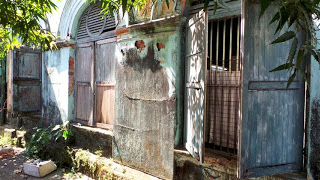 Yangon's Crumbling Buildings
Yangon's Crumbling BuildingsWe followed the walking tour plan in Lonely Planet, starting at a typical tea house with sickly sweet condensed milk tea and delicious samosas.
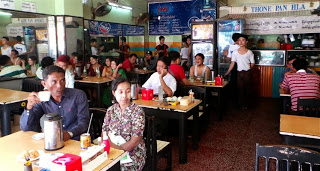 Yangon Tea House
Yangon Tea HouseJust outside the doors was a small stall selling betel nuts wrapped in green leaves and flavoured with spices and sesame. An English speaking guide persuaded us to try one. An interesting but 'never again' experience.
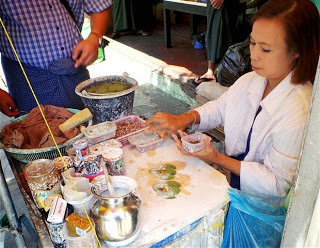 Beetle Juice Seller
Beetle Juice SellerStrolling around the streets of the older parts of Yangon was very interesting. The old telegraph office appears to be unchanged since its construction .Second hand book sellers, using the pavement as their counter, sell ancient dusty reference books dating back to the early 1900's.
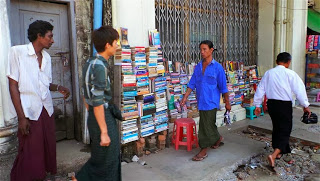 Street Book Stalls
Street Book StallsThe huge, grand, old buildings contrast with the dilapidated pavements and scruffy food stalls.
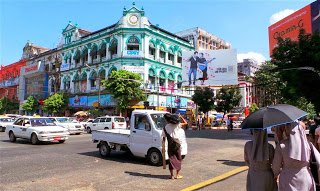 Yangon Colonial Buildings
Yangon Colonial BuildingsEverywhere there are people with little stalls selling everything from drinks and snacks...
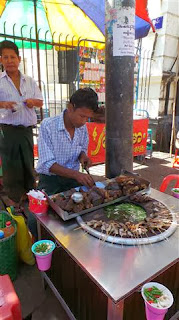 Kebab Seller
Kebab Seller....to public services such as typing or telephone calls...
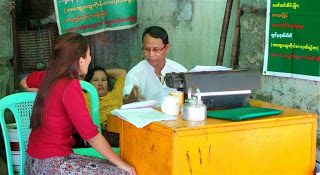 Street Typist
Street Typist...and clothing repairs and alterations.
And the most memorable thing is the friendliness and helpful nature of everyone.
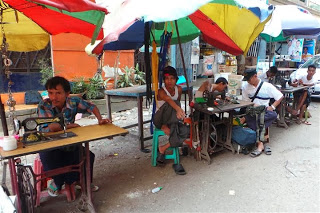 Clothing Repairs
Clothing RepairsTo escape the late morning heat we spent an hour at the Strand Hotel, built in 1900, which has been refurbished but retains many of its period features, with the welcome addition of air conditioning and amazing sandwiches with western style breads.
The bar and restaurant are open to visitors but the room prices are way above our budget.
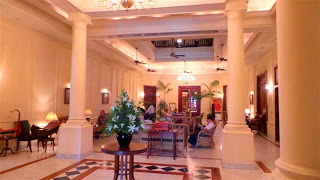 Yangon Strand Hotel
Yangon Strand HotelRefreshed with beer and lunch we ventured into the vibrant, noisy and colourful Indian market area and purchased a couple of traditional longhis.
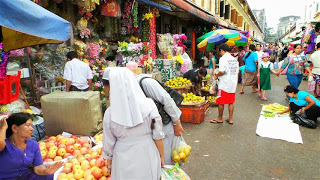 Yangon Market
Yangon MarketFrom the upper floor of the market is a pedestrian bridge across Mahabandula Road where you can watch the frantic, unrelenting and diverse traffic along this main thoroughfare in complete safety.
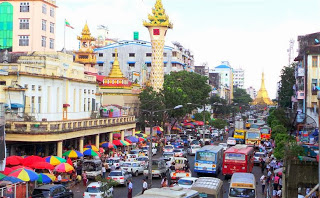 Yangon Mahabandoolah Street
Yangon Mahabandoolah StreetThis is a country where life revolves around the temple, with Buddhism the most prominent religion.
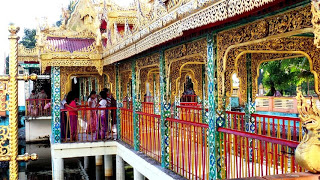 Yanong Botatung Paya
Yanong Botatung PayaThe temples are like small villages where people eat sleep and work
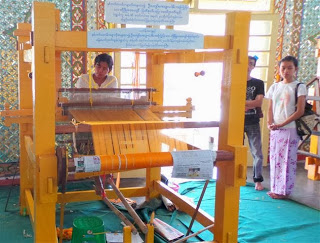 Weaving saffron coloured fabric for monks robes
Weaving saffron coloured fabric for monks robesShwedagon Paya Temple
Shwedagon Paya in north Yangon is the most important religious monument in Myanmar. Its enormous stupa, over 100m high, is covered in solid gold, reputed to weigh upwards of 60 tonnes and crowned with a jewel encrusted decorative top.
 Shwedagon Paya
Shwedagon PayaFour weeks in a country like Myanmar, where most tourist attractions are centred on religious sites, can test anyone's zeal for Buddha's, pagodas and stupas, but this one is really something special.
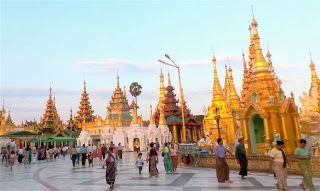 Shwedagon Paya
Shwedagon PayaWe arrived in the late afternoon, getting a taxi there in preference to cycling. It is impossible as a tourist to avoid paying the government $5 but at least this entitles you to a ride in the lift up to the temple plaza. This is one of the most beautiful as well as most well tended temples that we visited.
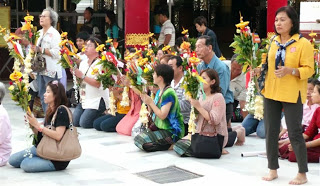 Saying Prayers At Schwedagon Paya
Saying Prayers At Schwedagon PayaThe floors are spotless and everywhere people are scrubbing, mopping and sweeping. As the sun was setting there was a cleaning ritual, with rows of women sweeping the floor followed by rows men with floor buffers.
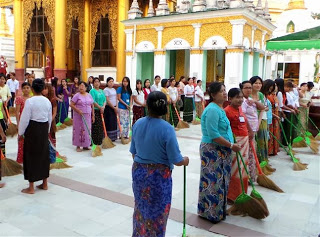 Ritual Sweeping At Schwedagon Paya
Ritual Sweeping At Schwedagon PayaThe magic about the place was the intense and varied activity all around. Groups of tourists with guides, families, people bringing offerings and praying, monks meditating or climbing the stupa to add more gold.
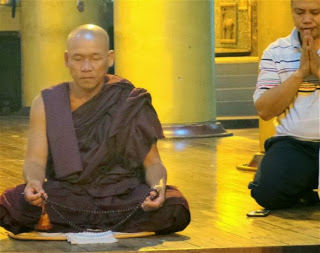 Meditation
MeditationAround every corner was yet another small shrine with a group of people praying and lighting candles. Although it was noisy and crowded there was a reverential air about it all and we were compelled to sit quietly on the side and try to take it all in.
 Monks Applying Gold Leaf to the Stupa
Monks Applying Gold Leaf to the StupaAs the sun set the gold stupa glowed and then once darkness fell it was illuminated by spotlights, contrasting with the star filled sky above.
For a fitting finale to a memorable evening we went to 'Monsoon ' restaurant, for a wonderful meal. Traditional Eastern food served to Western standards in a beautiful, air conditioned, restored colonial building.
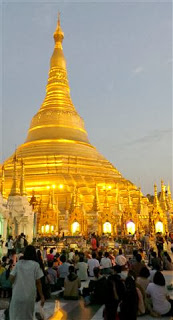 Stupa by night
Stupa by nightDalah
For our final full day we caught the ferry from the jetty on Strand Road to Dalah, on the opposite side of the Yangon River. This is a very busy ferry crossing and it was difficult getting the bikes down the crowded jetty and lifting them onto the boat in the great crush of people.
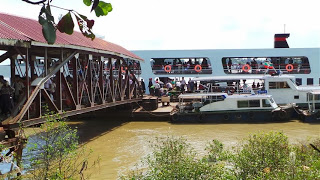 Pansodan Street Jetty
Pansodan Street JettyOnce on the boat we attracted a small crowd of interested locals who examined our bikes in detail. Although there are few bikes of this quality in Burma they quickly spotted the unusual features, the SIS couplings and the Rohloff hub and bombarded Steve with questions about them.
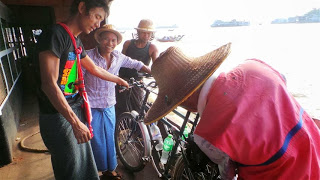 Fascinated with our Bikes
Fascinated with our BikesGetting off the ferry on the other side was even more of a crush, with all the passengers funnelling into a narrow street lined on both side with motorcycle taxis and pedicabs.
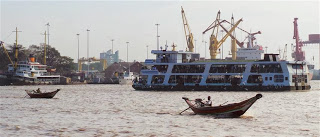 Yangon Harbour
Yangon HarbourEscaping the melee we set off down the road towards Twante. This delta area was very badly damaged by the cyclone in 2009 and has only recently been freely opened to tourists, without having to obtain a permit.
Parts of the road are in an extremely poor state of repair and made the ride tiring and there was little to delight the eye, few villages and even fewer people. The highlight of the 60km day was the river ferry crossing.
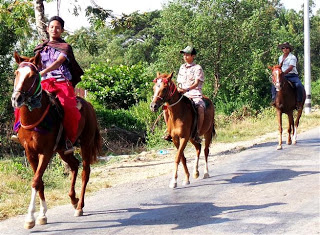 The first horse riders we'd seen with saddles
The first horse riders we'd seen with saddles
New! Comments
Have your say about what you just read! Leave me a comment in the box below.